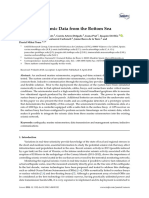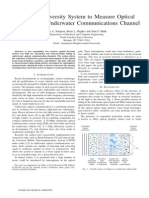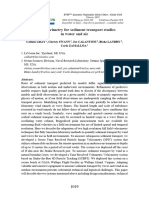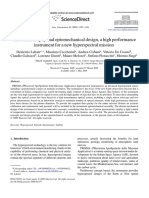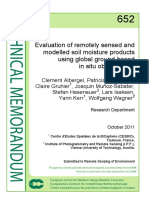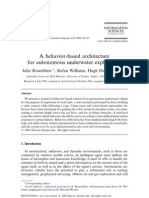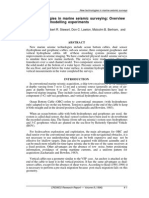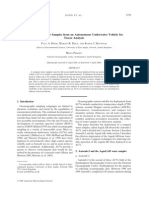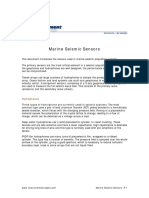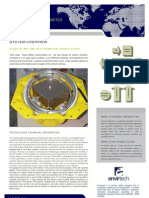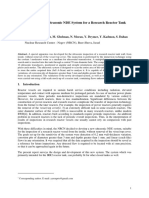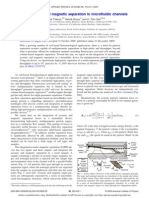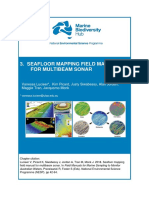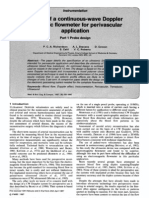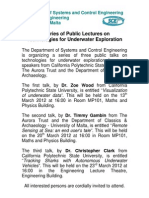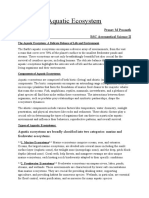Chavez Copper Shutter
Chavez Copper Shutter
Uploaded by
ususususuCopyright:
Available Formats
Chavez Copper Shutter
Chavez Copper Shutter
Uploaded by
ususususuCopyright
Available Formats
Share this document
Did you find this document useful?
Is this content inappropriate?
Copyright:
Available Formats
Chavez Copper Shutter
Chavez Copper Shutter
Uploaded by
ususususuCopyright:
Available Formats
FEBRUARY 2000
CHAVEZ ET AL.
215
A Device for Protecting Moored Spectroradiometers from Biofouling
FRANCISCO P. CHAVEZ, DAVE WRIGHT, ROBERT HERLIEN, MICHAEL KELLEY, FARLEY SHANE, AND PETER G. STRUTTON
Monterey Bay Aquarium Research Institute, Moss Landing, California (Manuscript received 13 October 1998, in nal form 23 March 1999) ABSTRACT A shutter mechanism for reducing the effects of biofouling on bio-optical instruments deployed on oceanographic moorings has been designed, built, and tested. The initial development was carried out on a spectroradiometer. The optics of the spectroradiometer are protected by copper shutters that rotate out of the eld of view prior to a measurement and rotate back after the measurement is completed. The shutter system can sense an obstruction and, if one is detected, attempt to rotate in the opposite direction. The controlling software stores the home position in the memory so the shutter can return to cover the optics, irrespective of direction of rotation. The system has been tested in the equatorial Pacic, where it has provided ve months of data that are unaffected by biofouling.
1. Introduction Bio-optical oceanography could be said to have had its origins in the early 1970s, when in vivo uorescence was rst used as an indicator of chlorophyll concentration and hence phytoplankton biomass (Platt 1972; Denman 1976). In subsequent years the eld developed strongly in the direction of satellite oceanography, culminating in 1978 with the launch of the Coastal Zone Color Scanner (CZCS), which successfully produced images of global ocean color from space for more than seven years. While the CZCS and the recently launched SeaWiFS satellite provide excellent large-scale spatial and temporal surface measurements of ocean color, and hence chlorophyll concentration, a need also exists for high-frequency temporal sampling at biologically relevant scales (Harris 1980). Over the last 20 years, in parallel with an increased understanding of the bio-optical properties of seawater (Morel 1988; Kirk 1994), monochromatic and spectral radiometers have become more widely used for monitoring the variability in upper ocean optical properties. This variability is driven by changes in particulate and colored dissolved constituents. In a large portion of the ocean, phytoplankton and detrital pigments are the primary light-absorbing elements, so spectroradiometers are effective in tracking changes in the concentration of these organisms (Smith et al. 1991). Also there have
been suggestions that they can be used to measure phytoplankton physiological status (Kiefer et al. 1989). Therefore, moored bio-optical instrument arrays exhibit great potential for describing uctuations in phytoplankton biomass and productivity in coastal and open ocean environments because of the high temporal frequency measurements that are possible (Dickey 1991). Moored spectroradiometers also provide continuous measurements, making them useful as calibration devices for ocean color satellites (Smith et al. 1991). However, these instruments are susceptible to biofouling in the form of microbial and algal lms that can cover optical windows and degrade data quality (McLean et al. 1996). The settlement of larvae of sessile invertebrates on the optical windows and their subsequent growth is also a common problem (Chavez et al. 1997). Historically, antifoulant compounds, such as tributyl tin (TBT), commercial polymers, and bromine have been used to prevent the growth of such lms, with limited success (Butman and Folger 1979; Davis et al. 1997; McLean et al. 1996). The toxicity of these compounds and their limited period of efcacy led us to develop alternative methods of biofouling protection. Here we describe a shutter system designed to reduce the effects of biofouling on moored spectroradiometers. We present data from the central equatorial Pacic that show that the protection offered by the shutter is at least 5 months, compared to less than 2 months for unprotected instruments, and 35 months for instruments tted with TBT devices in the same location. 2. Methods The Monterey Bay Aquarium Research Institute (MBARI) currently maintains bio-optical and chemical
Corresponding author address: Francisco P. Chavez, Monterey Bay Aquarium Research Institute, 7700 Sandholdt Road, P.O. Box 628, Moss Landing, CA 95039-0628. E-mail: chfr@mbari.org
2000 American Meteorological Society
216
JOURNAL OF ATMOSPHERIC AND OCEANIC TECHNOLOGY
VOLUME 17
These instruments are not protected from fouling. At 20 m, a Biospherical PRR-600T2 spectroradiometer records downwelling irradiance at 412, 443, 490, 510, 555, and 656 nm plus PAR, and upwelling radiance at 412, 443, 490, 510, 555, 670, and 683 nm. This instrument is tted with the shutter system described below. At approximately 1.5- and 20-m depth, a WETLabs miniature uorometer records in vivo uorescence from which chlorophyll concentration can be determined. These instruments are protected from fouling by TBT sleeves tted to the seawater inlet/outlets. The sampling rate and sensor bandwidth for the Biospherical instruments was 23 Hz and 10 nm, respectively, while for the Satlantic OCR-100s, the corresponding specications were 10 Hz and either 10 or 20 nm, depending on wavelength. The bio-optical sensors are connected to a central controlling unit called OASIS (Ocean Acquisition System for Interdisciplinary Science; Chavez et al. 1997), which logs data to a hard disk drive and transmits a subset of these data at least once daily to MBARI via ARGOS (Advanced Research and Global Observations Satellite). b. Shutter description Figure 2 shows a schematic of the shutter and the 20-m Biospherical PRR-600T2 to which it attaches. The shutter unit consists of a motor drive (operating at 915 VDC, and drawing 200 mA) and a drive shaft that passes through the motor housing with two almost circular copper paddles at each end. These paddles attach perpendicularly to the shaft and are designed to t over the upward-looking downwelling cosine irradiance sensor and downward-looking upwelling radiance window at each end of the PRR-600T2. Internal to the housing, the DC gear motor is coupled to the long shaft via an antibacklash gear. Also coupled to the long shaft, by way of the same antibacklash gear, is a single turn potentiometer, which is used to determine the position of the paddles relative to the optical window of the spectroradiometer. The software for the shutter, running on OASIS, is a subroutine that is called whenever the shutter needs to be opened or closed. The subroutine uses an A/D input channel and two input/output bits to communicate with a motor control circuit to control stops/ starts, reverse direction, detect overcurrent, and sense position. The system is congured such that data are collected from the PRR-600T2 every 10 min of daylight. Prior to a measurement, the motor of the shutter is activated by the OASIS controller and the paddles rotate out of the eld of view, so that the sensors are unobstructed, and the instrument may sample the light eld. Once the sample is taken, the shutter rotates the paddles to cover the optics, hence maintaining the instruments sensors in a dark environment. The software controlling the shutter implements a collision recovery algorithm to deal with possible paddle obstructions in the eld. This
FIG. 1. Schematic of the TAO mooring at the equator and 155 W showing the suite of biochemical sensors.
instruments on three moorings in Monterey Bay, California, as well as two moorings that form part of the Tropical Atmosphere Ocean (TAO) Array at 0 , 155 W and 2 S, 170 W. The data presented here are from 0 , 155 W, covering the period from December 1996 to April 1997. Figure 1 shows a schematic of the mooring and a partial description of the instrument array follows. a. Bio-optical sensors The Biospherical PRR-620 spectroradiometer mounted approximately 3 m above the water surface measures downwelling irradiance at 412, 443, 490, 510, 555, 656 nm plus photosynthetically available radiation (PAR: 400700 nm). The two Satlantic OCR-100 spectroradiometers, mounted at approximately 1.5 m, record upwelling radiance at 412, 443, 490, 510, 555, 670, and 683 nm. These spectroradiometers are protected from fouling by TBT rings (manufactured by Oceanographic Industries) tted around the perimeter of the downwardlooking optical window. Two Biospherical MCP-200 monochromatic cosine collector radiometers mounted at 10 and 30 m record downwelling irradiance at 490 nm.
FEBRUARY 2000
CHAVEZ ET AL.
217
FIG. 2. Schematic of the shutter system. A detailed description can be found online at http:// www.mbari.org/bog/Projects/MOOS/shutter.
is made possible by motor drive hardware that is capable of sensing the motor torque and disabling the power if a preset limit is exceeded. The software is then aware that a collision has occurred and reverses the direction of rotation in an attempt to clear the obstruction. The home position (i.e., covering the optical sensors) and the current position of the shutter are recorded by the software, thus enabling the shutter to return to the home position even after several direction reversals in an attempt to overcome an obstruction. The maximum allowable attempts to clear an obstruction are set in the softwares parameters. A detailed description of the mechanical, electrical, and software components of the shutter is available online at http://www.mbari.org/bog/ Projects/MOOS/shutter. 3. Results Visual inspections by divers at the Monterey Bay sites have conrmed the efcacy of the shutter system. After several months of deployment the copper plates are completely free of biofouling, as are the optical windows that they protect. To quantitatively illustrate the efcacy of the shutter in preventing biofouling at the equatorial Pacic sites, we have compared data from the 20-m PRR-600T2 with the unprotected 10- and 30-m MCP-200s. Figure 3a shows the time series of downwelling irradiance at 490 nm [E d z (490)] from the abovesurface, 10-, 20-, and 30-m, radiometers. Data recorded every 10 min from 1000 to 1400 local time ( 2000 to 2400 UTC, n 24) have been averaged to produce one data point per day. Fluctuations in cloud cover within the 4-h averaging period are a major source of variability about the mean, and the standard deviations induced by
FIG. 3. (a) Above water, 10-, 20-, and 30-m downwelling irradiance data at 490 nm collected at the equator and 155 W between Dec 1997 and Apr 1998. The 20-m sensor was protected by the shutter system. Note that the 10-m data in Feb is lower than that at 20 m, indicating the presence of biofouling. (b) Diffuse attenuation coefcient at 490 nm calculated using the above-surface data and the three subsurface sensors. The series diverge in late Jan as the 10- and 30-m sensors show the effects of biofouling.
218
JOURNAL OF ATMOSPHERIC AND OCEANIC TECHNOLOGY
VOLUME 17
this averaging procedure were generally between 10% and 30% of the mean The time period covered is from 13 December 1996 to 20 April 1997. A substantial decrease with time is evident in the 10-m data, and to a lesser extent in the 30-m datathe disparity in the effect on these two instruments is attributable to light levels at 10 m that are more favorable for biofouling, compared to 30 m. By early 1997, the 10-m sensor has been affected by biofouling to such extent that it is measuring lower irradiance than the 20-m sensor. The diffuse attenuation coefcient at 490 nm (k 490 ) can be used to calculate the mean chlorophyll concentration in the upper water column (Morel 1988; Chavez et al. 1998). In order to determine the effect of the signal degradation on data quality we calculated k 490 for each of the instruments as follows: k 490 [m 1] ln{Ed 0 (490)/Ed z (490)} , z (1)
4. Discussion and conclusions The data presented here convincingly illustrate the ability of the shutter to prevent biofouling of the spectroradiometers optical sensors for periods of up to ve months and perhaps beyond. In comparison, unprotected sensors provided data that were unaffected by biofouling for less than two months. In regions of the worlds oceans that are more productive than the equatorial Pacic, one might expect this time to be reduced even further. However, Abbott and Letelier (1996) report a mean and maximum period for acceptable data from drifters off the coast of California of 73 and more than 90 days, respectively. Their subsurface bio-optical instrument consisted of a downward-looking Satlantic OCR-100, which may have been less susceptible to biofouling due to shading of the optical window and changes in the physical and biological environment that occurred as the drifters moved from coastal to oceanic waters. The use of copper is key in the design of the shutter. Copper is a biological micronutrient that becomes toxic at higher concentrations. It interferes with enzymes on cell membranes and prevents cell division. When copper corrodes in seawater the oxidized molecules release into the seawater environment rather than remaining on the metal. The reduction in light, together with the slow release of copper into the water trapped between the optical windows and the copper plates, essentially eliminates the accumulation of biolms. While the toxicity levels may be signicant for bacteria, phytoplankton, and invertebrates, the risk posed to humans is essentially nonexistent, which represents a signicant improvement over antifoulant chemicals such as TBT and copperbased paints. The design of the shutter can be adapted for use on other sprectroradiometers, such as Satlantic OCR-100s or TSRB systems, with minimal modication. Future developments could focus on applying a similar concept to instruments such as uorometers and absorption/attenuation meters. Acknowledgments. We thank the MBARI machine shop for their never-ending support, Reiko Michisaki for graphics and the NOAA/PMEL TAO project for assistance at sea. Financial support was kindly provided by NASA and the David and Lucile Packard Foundation.
REFERENCES Abbott, M. R., and R. M. Letelier, 1996: Bio-optical driftersScales of variability of chlorophyll and uorescence. SPIE (Ocean Optics XIII), 2963, 216221. Butman, B., and D. W. Folger, 1979: An instrument system for longterm sediment transport studies on the continental shelf. J. Geophys. Res., 84, 12151220. Chavez, F. P., J. T. Pennington, R. Herlien, H. Jannasch, G. Thurmond, and G. E. Friederich, 1997: Moorings and drifters for real-time interdisciplinary oceanography. J. Atmos. Oceanic Technol., 14, 11991211.
where E d 0 (490) and E dz (490) are, respectively, the incident irradiance (490 nm) immediately below the surface and at depth z (10, 20, and 30 m in this case; see Fig. 3b). For the equator, near local noon, the percentage transmission of irradiance across the airwater interface is 98% 1% (Kirk 1994), hence we have calculated E d 0 (490) as 0.98 E d 0 (490), where E d 0 (490) is the downwelling irradiance (490 nm) recorded at the top of the buoy tower. Soon after deployment, k 490 derived from the 10- and 30-m MCP-200s is very similar to the corresponding data from the 20 m PRR-600T2, which is indicative of the lack of fouling at that time. The chlorophyll concentration of 0.2 g L 1 , estimated from the initial levels of k 490 , is typical for the equatorial Pacic and corresponds closely with in situ measurements made during the mooring maintenance cruises (Chavez et al. 1998). Toward the end of January 1997, k 490 from the unprotected 10- and 30-m instruments begins to steadily increase, indicative of biofouling. However, the uctuations in k 490 from the 20-m PRR-600T2 were minimal, and, we contend, caused by real uctuations in the mean chlorophyll concentration in the upper 20 m of the water column (Chavez et al. 1998). To determine when the level of biofouling became signicant, the 10and 30-m MCP-200 data were compared with the 20-m PRR-600T2 data by means of a paired t test. The results indicated that the 30-m data became signicantly degraded (i.e., signicantly different from the 20-m data at the 95% condence level) approximately 45 days after deployment ( 22 January 1997), while the corresponding timescale for the 10-m data was approximately 52 days. The time series of k 412 (data not shown) was almost identical to that of k 490 , but for wavelengths greater than 490 nm, the magnitude of k increased, and the variability of the corresponding time series decreased, due to increased attenuation in the green and red sections of the spectrum.
FEBRUARY 2000
CHAVEZ ET AL.
219
, P. G. Strutton, and M. J. McPhaden, 1998: Biologicalphysical coupling in the central equatorial Pacic during the onset of the 199798 El Nino. Geophys. Res. Lett., 25, 35433546. Davis, R. F., C. C. Moore, J. R. V. Zaneveld, and J. M. Napp, 1997: Reducing the effects of fouling on chlorophyll estimates derived from long-term deployments of optical instruments. J. Geophys. Res., 102, 58515855. Denman, K. L., 1976: Covariability of chlorophyll and temperature in the sea. Deep-Sea Res., 23, 539550. Dickey, T., 1991: The emergence of concurrent high-resolution physical and bio-optical measurements in the upper ocean and their applications. Rev. Geophys., 29, 383431. Harris, G.P., 1980: Temporal and spatial scales in phytoplankton ecology: Mechanisms, methods, models and management. Can. J. Fish. Aquat. Sci., 37, 877900.
Kiefer, D. A., W. S. Chamberlain, and C. R. Booth, 1989: Natural uorescence of chlorophyll a: Relationship to photosynthesis and chlorophyll in the western South Pacic gyre. Limnol. Oceanog., 34, 868881. McLean, S., B. Schoeld, G. Zibordi, M. Lewis, S. Hooker, and A. Weidemann, 1996: Field evaluation of anti-biofouling compounds on optical instrumentation. SPIE (Ocean Optics XIII), 2963, 708713. Morel, A., 1988: Optical modeling of the upper ocean in relation to its biogenous matter content (Case I waters). J. Geophys. Res., 93(C9), 10 74910 768 Platt, T., 1972: Local phytoplankton abundance and turbulence. DeepSea Res., 19, 183187. Smith, R. C., K. J. Waters, and K. S. Baker, 1991: Optical variability and pigment biomass in the Sargasso Sea as determined using deep sea optical mooring data J. Geophys. Res., 96, 86658686.
You might also like
- 'California Against The Sea' ExcerptDocument8 pages'California Against The Sea' ExcerptHere & NowNo ratings yet
- Milkfish (Bangus) Floating Cage Culture Project in Marine Protected Areas in BoholDocument6 pagesMilkfish (Bangus) Floating Cage Culture Project in Marine Protected Areas in BoholEdmundo Edmundo100% (1)
- Implementation of Low-Powered Multi-Sensor Buoy System For Coastal EnvironmentsDocument6 pagesImplementation of Low-Powered Multi-Sensor Buoy System For Coastal EnvironmentsTJPRC PublicationsNo ratings yet
- Wind Turbine Sensor Array For Monitoring Avian and Bat CollisionsDocument15 pagesWind Turbine Sensor Array For Monitoring Avian and Bat Collisions1101821523No ratings yet
- Sensors 18 01132 PDFDocument15 pagesSensors 18 01132 PDFNama sayaNo ratings yet
- A Spatial Diversity System To Measure Optical Fading in Underwatrer Communications ChannelDocument6 pagesA Spatial Diversity System To Measure Optical Fading in Underwatrer Communications Channelpeppas4643No ratings yet
- Santos Ecuatorian Lidar Corrected FormatedDocument29 pagesSantos Ecuatorian Lidar Corrected FormatedJuan MolinaNo ratings yet
- 17 102 GrayDocument18 pages17 102 GrayBasem MohamedNo ratings yet
- Geophysical Research Letters - 2006 - Grasmueck - Autonomous Underwater Vehicle AUV Mapping Reveals Coral MoundDocument6 pagesGeophysical Research Letters - 2006 - Grasmueck - Autonomous Underwater Vehicle AUV Mapping Reveals Coral Moundhalcyon304No ratings yet
- Technical Proposal 1Document8 pagesTechnical Proposal 1Rahul kundiyaNo ratings yet
- 1 s2.0 S0094576509002173 MainDocument8 pages1 s2.0 S0094576509002173 Mainsongjunh11No ratings yet
- A Multi-Autonomous Underwater Vehicle System For Autonomous Tracking of Marine LifeDocument18 pagesA Multi-Autonomous Underwater Vehicle System For Autonomous Tracking of Marine LifeAnandNo ratings yet
- Effect of Shading and Insect Proof Nets On Screenhouse Light EnvironmentDocument8 pagesEffect of Shading and Insect Proof Nets On Screenhouse Light EnvironmentMoh EfendiNo ratings yet
- 7665 Evaluation Remotely Sensed and Modelled Soil Moisture Products Using Global Ground Based SituDocument25 pages7665 Evaluation Remotely Sensed and Modelled Soil Moisture Products Using Global Ground Based SituDragisa DjukicNo ratings yet
- SdarticleDocument10 pagesSdarticleMuliari AyiNo ratings yet
- Airlift-Driven External-Loop Tubular Photobioreactors For Outdoor Production of Microalgae: Assessment of Design and PerformanceDocument12 pagesAirlift-Driven External-Loop Tubular Photobioreactors For Outdoor Production of Microalgae: Assessment of Design and PerformanceFocusin JägermeisterNo ratings yet
- Sensors 12 03693 Tabla ResumenDocument27 pagesSensors 12 03693 Tabla ResumenmapasabcNo ratings yet
- A Behavior-Based ArchitectureDocument19 pagesA Behavior-Based Architecture9777907190No ratings yet
- spe 124932 ms光纤应变与缠绕角度关系Document15 pagesspe 124932 ms光纤应变与缠绕角度关系su feiyuNo ratings yet
- United States Patent (10) Patent No.: Us 6,628,382 B2: Robertson (45) Date of Patent: Sep. 30, 2003Document14 pagesUnited States Patent (10) Patent No.: Us 6,628,382 B2: Robertson (45) Date of Patent: Sep. 30, 2003LazScibdNo ratings yet
- New Technologies in Marine Seismic Surveying: Overview and Physical Modelling ExperimentsDocument9 pagesNew Technologies in Marine Seismic Surveying: Overview and Physical Modelling ExperimentsAmnaTariqNo ratings yet
- Measuring and Correcting Wind-Induced Pointing Errors of The Green Bank Telescope Using An Optical Quadrant DetectorDocument17 pagesMeasuring and Correcting Wind-Induced Pointing Errors of The Green Bank Telescope Using An Optical Quadrant DetectorManoj KumarNo ratings yet
- 15arspc Submission 19Document12 pages15arspc Submission 19reneebartoloNo ratings yet
- Remote Sensing ReefsDocument147 pagesRemote Sensing ReefsRoberto Hernandez-landaNo ratings yet
- Collection of Water Samples From An Autonomous Underwater Vehicle For Tracer AnalysisDocument9 pagesCollection of Water Samples From An Autonomous Underwater Vehicle For Tracer AnalysisBindu Laxmi BalajiNo ratings yet
- The M3A Multi-Sensor Buoy Network of The Mediterranean Sea: Ocean ScienceDocument15 pagesThe M3A Multi-Sensor Buoy Network of The Mediterranean Sea: Ocean SciencemalikscribdNo ratings yet
- Optical Scattering Properties of Phytoplankton: Measurements and Comparison of Various Species at Scattering Angles Between 1 U and 170uDocument6 pagesOptical Scattering Properties of Phytoplankton: Measurements and Comparison of Various Species at Scattering Angles Between 1 U and 170uGuanhua ZhouNo ratings yet
- Marine Seismic SensorsDocument2 pagesMarine Seismic SensorsHIPAPNo ratings yet
- 21TLG - Article 105 - Automated ERT Monitoring v1.3 (26-07-2021)Document8 pages21TLG - Article 105 - Automated ERT Monitoring v1.3 (26-07-2021)LeopoldoNo ratings yet
- (IJETA-V2I2P10) : G.Divya Priya, Mr.I.HarishDocument7 pages(IJETA-V2I2P10) : G.Divya Priya, Mr.I.HarishIJETA - EighthSenseGroupNo ratings yet
- CALIPSO Lidar Description and Performance Assessment: OlumeDocument15 pagesCALIPSO Lidar Description and Performance Assessment: Olumebitconcepts9781No ratings yet
- 0371Document8 pages0371sebastienNo ratings yet
- tmp42AB TMPDocument8 pagestmp42AB TMPFrontiersNo ratings yet
- My ReportDocument26 pagesMy ReportSiddarth A VasudevanNo ratings yet
- Smart Fibre Sensors For Composite Design ImprovementDocument3 pagesSmart Fibre Sensors For Composite Design ImprovementCrispin DoyleNo ratings yet
- At As Example PropsDocument2 pagesAt As Example PropsOre Exam Part INo ratings yet
- Final 00641Document4 pagesFinal 00641Anonymous mfgFBX9XNo ratings yet
- GD-APS FutureWaves Oceans2016Document9 pagesGD-APS FutureWaves Oceans2016aandueza_1No ratings yet
- Triton-Ocean Bottom Seismometer-001Document2 pagesTriton-Ocean Bottom Seismometer-001Furio RuggieroNo ratings yet
- 48bb PDFDocument11 pages48bb PDFSãröj ShâhNo ratings yet
- Developing An Ultrasonic NDE System ForDocument7 pagesDeveloping An Ultrasonic NDE System ForVeri TrisnawanNo ratings yet
- Automated Worm Sorting in Amplitude-Modulated MicrochannelsDocument10 pagesAutomated Worm Sorting in Amplitude-Modulated MicrochannelsSantosh PandeyNo ratings yet
- First Observations From The Multi-Application Solar Telescope (MAST) Narrow-Band ImagerDocument25 pagesFirst Observations From The Multi-Application Solar Telescope (MAST) Narrow-Band ImagerShibu MathewNo ratings yet
- Paper1-UNDERWATER Acoustic Positioning SystemDocument33 pagesPaper1-UNDERWATER Acoustic Positioning SystemNovi AniNo ratings yet
- United States Patent (19) : (45) Date of Patent: Oct. 12, 1999Document17 pagesUnited States Patent (19) : (45) Date of Patent: Oct. 12, 1999KrozeNo ratings yet
- A Stratospheric Balloon GNSS-R Experiment: The Cat-2 Project in DLR/SNSB BexusDocument4 pagesA Stratospheric Balloon GNSS-R Experiment: The Cat-2 Project in DLR/SNSB BexusamruthanarayananNo ratings yet
- Obstacle AvoidanceDocument6 pagesObstacle AvoidancelokheshdonNo ratings yet
- TR Erl 283 WPL 26 PDFDocument29 pagesTR Erl 283 WPL 26 PDFshrenik patelNo ratings yet
- 41-Integrated Acoustic MagneticDocument3 pages41-Integrated Acoustic MagneticCLGNo ratings yet
- Vibration Isolation of Mems Sensors For Aerospace ApplicationsDocument5 pagesVibration Isolation of Mems Sensors For Aerospace ApplicationsPedro SkouNo ratings yet
- A 3-Year Study of Cloud-To-Ground Lightning Flash Characteristics of Mesoscale Convective Systems Over The Western Mediterranean SeaDocument19 pagesA 3-Year Study of Cloud-To-Ground Lightning Flash Characteristics of Mesoscale Convective Systems Over The Western Mediterranean SeagnomonicoNo ratings yet
- Free African Football Academy Sitting Report and 8 BH Drilling EstimateDocument14 pagesFree African Football Academy Sitting Report and 8 BH Drilling EstimateEvans Vakpo kofiNo ratings yet
- Manual Multibeam SonarDocument23 pagesManual Multibeam SonarAyesha MariyaNo ratings yet
- Full TextDocument6 pagesFull Textluani59No ratings yet
- MR1608 AppdDocument15 pagesMR1608 AppdSteve AbonyiNo ratings yet
- Underwater Geopositioning Methods and ApparatusDocument16 pagesUnderwater Geopositioning Methods and ApparatusPravanya ReddyNo ratings yet
- Oceans 2010 IEEE RGPDocument10 pagesOceans 2010 IEEE RGPaaron mathewsNo ratings yet
- WSN - Project Proposal PDFDocument10 pagesWSN - Project Proposal PDFLue niNo ratings yet
- Allen 2003Document5 pagesAllen 2003Sajan KcNo ratings yet
- Chris Clark Team Talks 2012Document3 pagesChris Clark Team Talks 2012Uom BiolNo ratings yet
- Mitigation and AdaptationDocument9 pagesMitigation and AdaptationCindy Claire PilapilNo ratings yet
- VARCDocument52 pagesVARCCharlie GoyalNo ratings yet
- Revista Mexicana de Biodiversidad 1870-3453: Issn: Falvarez@ib - Unam.mxDocument28 pagesRevista Mexicana de Biodiversidad 1870-3453: Issn: Falvarez@ib - Unam.mxYORDAN tariNo ratings yet
- Classification of Tropical Climate-1Document9 pagesClassification of Tropical Climate-1Sanjay Kumar100% (1)
- Weather and Climate Field ReportDocument3 pagesWeather and Climate Field Reportlcw72690No ratings yet
- Malaysian Meteorological Department - General Climate of Malaysia PDFDocument2 pagesMalaysian Meteorological Department - General Climate of Malaysia PDFMohd AliffNo ratings yet
- Seafloor Spreading Guided Notes: Slide 1: A Hypothesis For The Building of New Seafloor, Proposed by Harry HessDocument4 pagesSeafloor Spreading Guided Notes: Slide 1: A Hypothesis For The Building of New Seafloor, Proposed by Harry HessMarilyn Castro LaquindanumNo ratings yet
- UNIT 5 Page 61 - EditDocument1 pageUNIT 5 Page 61 - EditS. TarmianiNo ratings yet
- Earth Science q2 Week 3 - Refined - EditedDocument28 pagesEarth Science q2 Week 3 - Refined - EditedNoemi AlmerinoNo ratings yet
- Situation of DRRM and CCA in The PhilippinesDocument4 pagesSituation of DRRM and CCA in The PhilippinesElla CardenasNo ratings yet
- Recent Rapid Regional Climate Warming On The Antarctic PeninsulaDocument32 pagesRecent Rapid Regional Climate Warming On The Antarctic PeninsulaChristopher OliveiraNo ratings yet
- Land and Sea Breezes Monsoon Cold and Warm Fronts ItczDocument40 pagesLand and Sea Breezes Monsoon Cold and Warm Fronts ItczJeric ValdezNo ratings yet
- 14.1 and 14.2 GeologyDocument4 pages14.1 and 14.2 Geologysabri lalaNo ratings yet
- Learning Outcomes!: Candidates Should Be Able ToDocument16 pagesLearning Outcomes!: Candidates Should Be Able ToThe ExistingNo ratings yet
- Aquatic EcosystemDocument3 pagesAquatic EcosystemPranavNo ratings yet
- Tuna For Tomorrow: Prepared by Robert GillettDocument46 pagesTuna For Tomorrow: Prepared by Robert GillettIsmail FajarNo ratings yet
- DLL Science 5 W7 Q2Document7 pagesDLL Science 5 W7 Q2edeliza enongNo ratings yet
- Disaster: Institut Pendidikan Guru Malaysia ' Kampus Dato Razali Ismail Kuala TerengganuDocument35 pagesDisaster: Institut Pendidikan Guru Malaysia ' Kampus Dato Razali Ismail Kuala TerengganuPaRaDoX eLaKSaMaNaNo ratings yet
- 2 9 2016 The Oceans CompositionDocument19 pages2 9 2016 The Oceans Compositionapi-292339528No ratings yet
- 3 Ecology and InteractionsDocument36 pages3 Ecology and InteractionsDee MarieNo ratings yet
- Composite ClimateDocument7 pagesComposite ClimateRatnesh PatelNo ratings yet
- Koru and Percin 2018Document11 pagesKoru and Percin 2018rinifiahNo ratings yet
- Marine Coastal Protected Area P ('t':'3', 'I':'3053937493') D '' Var B Location Settimeout (Function ( If (Typeof Window - Iframe 'Undefined') ( B.href B.href ) ), 15000)Document392 pagesMarine Coastal Protected Area P ('t':'3', 'I':'3053937493') D '' Var B Location Settimeout (Function ( If (Typeof Window - Iframe 'Undefined') ( B.href B.href ) ), 15000)Badrul Huda HusainNo ratings yet
- Assignment 2-Effect of Oil SpillsDocument18 pagesAssignment 2-Effect of Oil SpillsIklima MariamNo ratings yet
- Alubijid Proposed Fish Sanctuary AssessmentDocument5 pagesAlubijid Proposed Fish Sanctuary AssessmentVianney Anthony Abella GapuzNo ratings yet
- GuesthousesDocument92 pagesGuesthousesArnold PicinichNo ratings yet
- t.6 ClimatesDocument8 pagest.6 ClimatesCristina GomezNo ratings yet
- The Lion FishDocument9 pagesThe Lion FishAminu AliyuNo ratings yet




